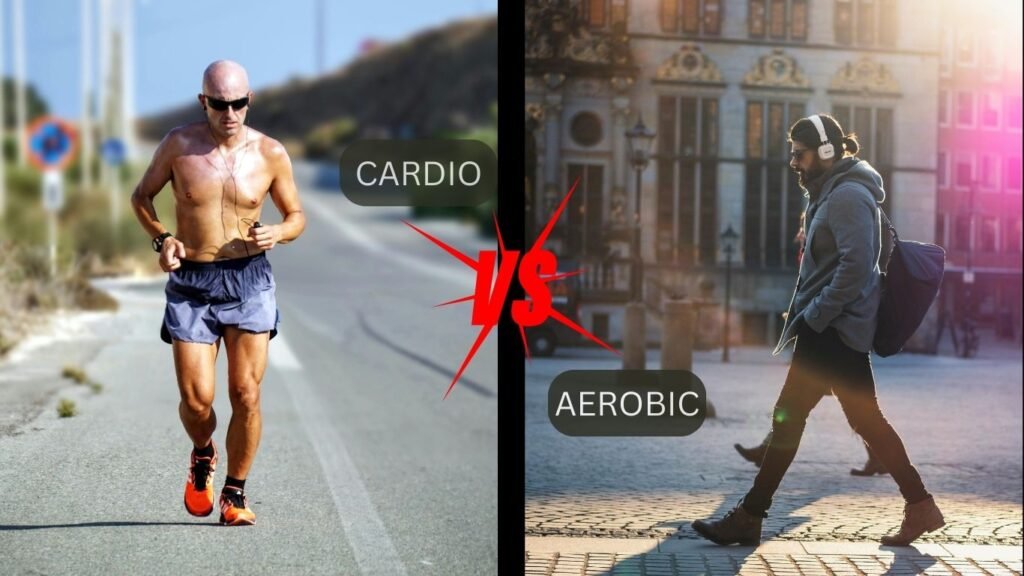When it comes to fitness, terms like “cardio” and “aerobic exercise” are often used interchangeably. However, while they share similarities, there are subtle distinctions between the two. Understanding these differences can help you tailor your workout regimen to meet your specific fitness goals. In this blog post, we’ll explore what sets cardio and aerobic exercises apart, their benefits, and how to incorporate them effectively into your routine. Let’ dive into the deep of cardio vs aerobic.

Defining Cardio vs Aerobic Exercise 👊
Cardio Exercise: Cardio, short for cardiovascular exercise, encompasses any physical activity that raises your heart rate and keeps it elevated for a prolonged period. The primary aim is to improve cardiovascular health by strengthening the heart and lungs. Cardio exercises can range in intensity from low to high and include activities like running, cycling, swimming, and high-intensity interval training (HIIT).
Aerobic Exercise: Aerobic exercise is a subset of cardio exercise that specifically involves rhythmic, continuous movements of large muscle groups. The term “aerobic” means “with oxygen,” indicating that these exercises rely on the aerobic energy-generating process. Aerobic exercises are typically performed at moderate intensity over extended periods and include activities like brisk walking, jogging, dancing, and rowing.
Key Differences
- Intensity and Duration:
- Cardio Exercise: Encompasses a broad spectrum of intensities, from low to high. High-intensity cardio, such as HIIT, involves short bursts of intense activity followed by rest or low-intensity periods.
- Aerobic Exercise: Generally focuses on moderate intensity maintained over a longer duration. The goal is to sustain a steady pace that keeps the heart rate elevated but manageable.
- Energy Systems:
- Cardio Exercise: Can engage both aerobic and anaerobic (without oxygen) energy systems, especially in high-intensity workouts where the body relies on stored glycogen for quick energy.
- Aerobic Exercise: Primarily utilizes the aerobic energy system, where oxygen is used to convert carbohydrates and fats into energy, making it ideal for endurance and stamina building.
- Health Benefits:
- Cardio Exercise: Improves cardiovascular health, increases metabolism, enhances lung capacity, and can lead to significant calorie burning and weight loss. It also boosts mental health by releasing endorphins.
- Aerobic Exercise: Enhances cardiovascular endurance, promotes efficient oxygen utilization, aids in weight management, and improves overall stamina. It also supports mental health and reduces stress levels.

Benefits of Cardio and Aerobic Exercise
Both types of exercise offer numerous health benefits, but the approach and outcomes can vary slightly.
Cardio Exercise:
- Weight Loss: High-intensity cardio, in particular, can lead to substantial calorie burning and fat loss.
- Heart Health: Strengthens the heart and improves circulation, reducing the risk of cardiovascular diseases.
- Metabolic Boost: Increases metabolic rate, which helps in burning more calories even at rest.
- Mental Health: Reduces anxiety, depression, and stress by releasing feel-good hormones like endorphins and serotonin.
Aerobic Exercise:
- Endurance and Stamina: Enhances the body’s ability to sustain prolonged physical activity.
- Oxygen Efficiency: Improves the efficiency of the respiratory system, enabling better oxygen uptake and delivery to muscles.
- Weight Management: Helps in maintaining a healthy weight by burning calories and promoting fat oxidation.
- Chronic Disease Prevention: Lowers the risk of chronic diseases such as type 2 diabetes, hypertension, and certain cancers.
Incorporating Cardio and Aerobic Exercise into Your Routine
To maximize the benefits of both cardio and aerobic exercises, it’s important to incorporate a variety of activities into your fitness regimen. Here are some practical tips:
- Mix It Up: Combine different types of cardio workouts, including both high-intensity and moderate-intensity sessions, to engage various muscle groups and energy systems.
- Consistency is Key: Aim for at least 150 minutes of moderate-intensity aerobic activity or 75 minutes of vigorous-intensity cardio each week, as recommended by health guidelines.
- Listen to Your Body: Pay attention to how your body responds to different exercises. Ensure you are not overtraining by allowing adequate rest and recovery.
- Set Goals: Establish clear fitness goals, whether it’s improving endurance, losing weight, or enhancing overall cardiovascular health, and tailor your workouts accordingly.
- Stay Engaged: Keep your workouts interesting by trying new activities, joining fitness classes, or working out with a partner to stay motivated.

Conclusion
While cardio and aerobic exercises share many similarities, understanding their differences can help you optimize your fitness routine. Learn More about different types of Cardiovascular training- https://fatburnfaster2x.com/how-many-types-of-cardiovascular-training-are-there/ Both forms of exercise are crucial for improving cardiovascular health, boosting metabolism, and enhancing mental well-being. By incorporating a balanced mix of cardio and aerobic activities into your weekly regimen, you can achieve a well-rounded fitness plan that supports your overall health and wellness goals.




Pingback: Power of Yoga: Transformation of Body - Fat Burn Faster 2x
Pingback: How Many Ways You Can Do Cardio Training? - Fat Burn Faster 2x